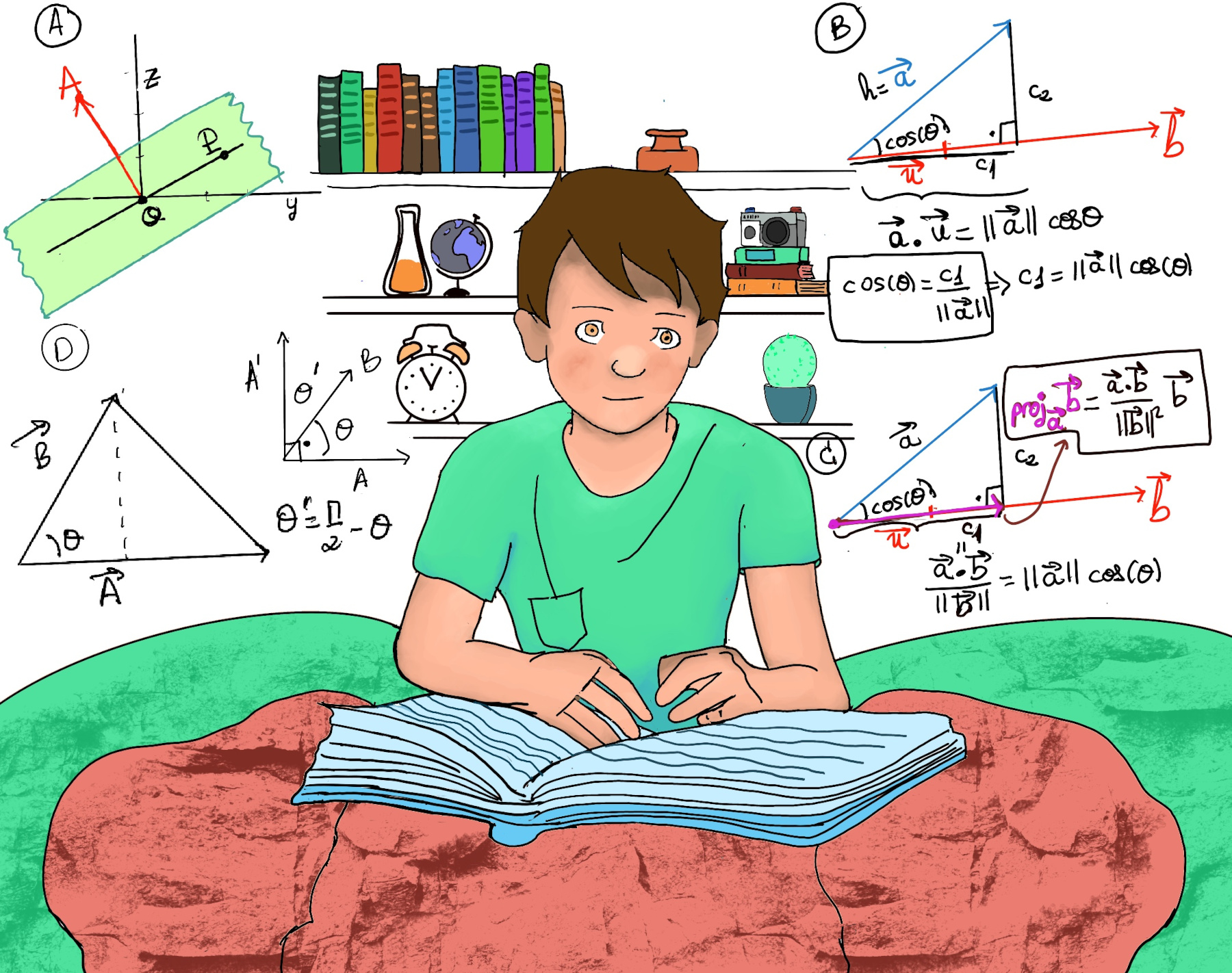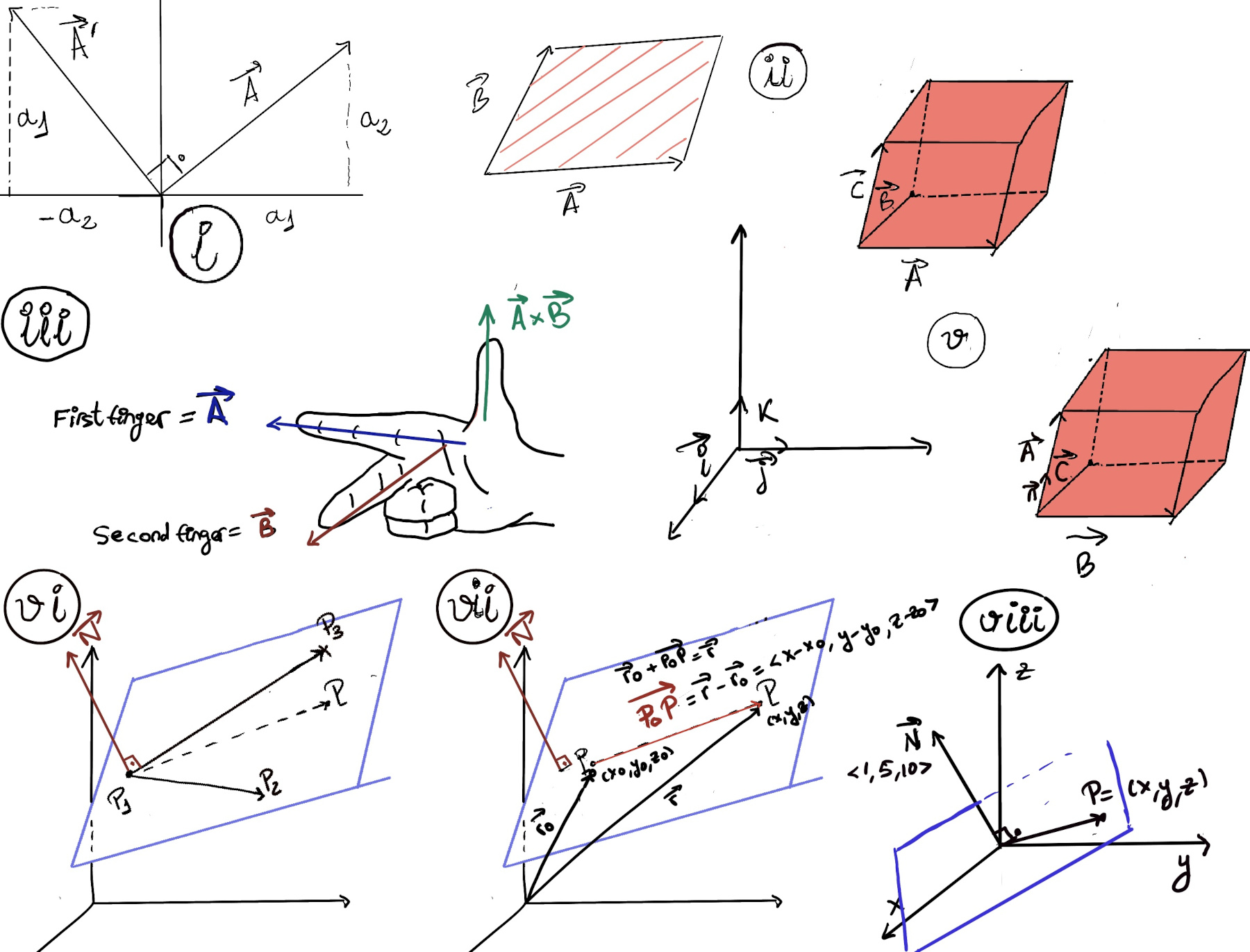
|
 |
 |

|
 |
 |
Sometimes people don’t want to hear the truth because they don’t want their illusions destroyed, the truth is too hard to bear, they don’t have the time or just don’t care or some unfathomable combination of the above, JustToThePoint, Anawim, #justtothepoint.
Definition. A vector $\vec{AB}$ is a geometric object that has magnitude (or length) and direction. Vectors in an n-dimensional Euclidean space can be represented as coordinates vectors in a Cartesian coordinate system.
Definition. The magnitude or length of the vector $\vec{A}$ is given by $|\vec{A}|~ or~ ||\vec{A}|| = \sqrt{a_1^2+a_2^2+a_3^2}$, e.g., $||< 3, 2, 1 >|| = \sqrt{3^2+2^2+1^2}=\sqrt{14}$, $||< 3, -4, 5 >|| = \sqrt{3^2+(-4)^2+5^2}=\sqrt{50}=5\sqrt{2}$, or $||< 1, 0, 0 >|| = \sqrt{1^2+0^2+0^2}=\sqrt{1}=1$.
The dot or scalar product is a fundamental operation between two vectors. It produces a scalar quantity that represents the projection of one vector onto another. The dot product is defined as follows: $\vec{A}·\vec{B} = \sum a_ib_i = a_1b_1 + a_2b_2 + a_3b_3,$ e.g. $\vec{A}·\vec{B} = \sum a_ib_i = ⟨2, 2, -1⟩·⟨5, -3, 2⟩ = a_1b_1 + a_2b_2 + a_3b_3 = 2·5+2·(-3)+(-1)·2 = 10-6-2 = 2.$

$det(\vec{A}, \vec{B}, \vec{C}) = [\begin{smallmatrix}a_1 & a_2 & a_3\\ b_1 & b_2 & b_3\\ c_1 & c_2 & c_3\end{smallmatrix}] = a_1[\begin{smallmatrix}b_2 & b_3\\ c_2 & c_3\end{smallmatrix}]-a_2[\begin{smallmatrix}b_1 & b_3\\ c_1 & c_3\end{smallmatrix}]+a_3[\begin{smallmatrix}b_1 & b_2\\ c_1 & c_2\end{smallmatrix}]$
Theorem. Geometrically, $det(\vec{A}, \vec{B}, \vec{C})$ = ± the volume of a parallelepiped spanned by the vectors $\vec{A}, \vec{B},and~ \vec{C}$(Figure ii).

Definition. The cross product, denoted by $\vec{A}x\vec{B}$, is a binary operation on two vectors in three-dimensional space. It is a vector that is perpendicular to both of the input vectors (perpendicular to the parallelogram) and has a magnitude equal to the area of the parallelogram formed by the two input vectors.
The direction of the resulting vector is determined by the right-hand rule: if you curl the fingers of your right hand from $\vec{A}$ to $\vec{B}$ (first finger points $\vec{A}$, second finger points to $\vec{B}$), your thumb points in the direction of $\vec{A} \times \vec{B}$ (Figure iii).

$\vec{A}x\vec{B} = [\begin{smallmatrix}i & j & k\\ a_1 & a_2 & a_3\\ b_1 & b_2 & b_3\end{smallmatrix}] =[\begin{smallmatrix}a_2 & a_3\\ b_2 & b_3\end{smallmatrix}]\vec{i}-[\begin{smallmatrix}a_1 & a_3\\ b_1 & b_3\end{smallmatrix}]\vec{j}+[\begin{smallmatrix}a_1 & a_2\\ b_1 & b_2\end{smallmatrix}]\vec{k}$
Examples:
Another way of seeing the volume of a parallelepiped spanned by the vectors $\vec{A}, \vec{B},and~ \vec{C}$ (Figure v)= base x height = $|\vec{B}x\vec{C}|(\vec{A}·\vec{n})$ where n is a unit vector perpendicular to the parallelogram formed by $\vec{B},and~ \vec{C}$ = $|\vec{B}x\vec{C}|(\vec{A}·\frac{\vec{B}x\vec{C}}{|\vec{B}x\vec{C}|}) = \vec{A}·(\vec{B}x\vec{C}) = det(\vec{A},\vec{B},\vec{C})$

Let’s check it out,
$det(\vec{A}, \vec{B}, \vec{C}) = [\begin{smallmatrix}a_1 & a_2 & a_3\\ b_1 & b_2 & b_3\\ c_1 & c_2 & c_3\end{smallmatrix}] = a_1[\begin{smallmatrix}b_2 & b_3\\ c_2 & c_3\end{smallmatrix}]-a_2[\begin{smallmatrix}b_1 & b_3\\ c_1 & c_3\end{smallmatrix}]+a_3[\begin{smallmatrix}b_1 & b_2\\ c_1 & c_2\end{smallmatrix}]$
$\vec{A}·(\vec{B}x\vec{C}) =\vec{A}·([\begin{smallmatrix}b_2 & b_3\\ c_2 & c_3\end{smallmatrix}]\vec{i}-[\begin{smallmatrix}b_1 & b_3\\ c_1 & c_3\end{smallmatrix}]\vec{j}+[\begin{smallmatrix}b_1 & b_2\\ c_1 & c_2\end{smallmatrix}]\vec{k}) = a_1[\begin{smallmatrix}b_2 & b_3\\ c_2 & c_3\end{smallmatrix}]-a_2[\begin{smallmatrix}b_1 & b_3\\ c_1 & c_3\end{smallmatrix}]+a_3[\begin{smallmatrix}b_1 & b_2\\ c_1 & c_2\end{smallmatrix}]$
Let $\vec{u}, \vec{v}$, and $\vec{w}$ be vectors in space, and let c be a scalar, the following statements hold true (Credits: The Cross Product -Mathematics Libre Texts),
We want to find the equation of a plane given three points P1, P2, and P3 in the plane. Let P be a fourth point, the condition that P is in the same plane is that the parallelepiped spanned by the vectors $\vec{P_1P}, \vec{P_1P_2},and~ \vec{P_1P_3}$ is flat (Figure vi) ↭ $det(\vec{P_1P}, \vec{P_1P_2},~ \vec{P_1P_3})$ = 0
Definition. A normal vector to a plane is a vector that is perpendicular to the plane, hence is perpendicular (orthogonal) to every vector that lies in the plane.
An alternative to the previously found solution is as follows, P is in the plane ↭ $\vec{P_1P}⊥\vec{N}$ where N is a normal vector to our plane ↭ $\vec{P_1P}·\vec{N}=0$
Such a normal vector could be found using the following formula, $\vec{N}=\vec{P_1P_2}x\vec{P_1P_3}$ ⇒[$\vec{P_1P}·\vec{N}=0$] $\vec{P_1P}·(\vec{P_1P_2}x\vec{P_1P_3})=0$ (Figure vi).

Recall that if P1 has coordinates (x1, y1, z1) and P2 has coordinates (x2, y2, z2), then the componentes of $\vec{P_1P_2}$ are ⟨x2-x1, y2-y1, z2-z1⟩, i.e., we subtract the coordinates of P1 from the coordinates of P2.
$\vec{P_1P_2} = ⟨2, 3, 4⟩, \vec{P_1P_3} = ⟨-1, 1, 2⟩$
$\vec{N}=\vec{P_1P_2}x\vec{P_1P_3} = [\begin{smallmatrix}i & j & k\\ a_1 & a_2 & a_3\\ b_1 & b_2 & b_3\end{smallmatrix}] = [\begin{smallmatrix}i & j & k\\ 2 & 3 & 4\\ -1 & 1 & 2\end{smallmatrix}] = 2\vec{i}-8\vec{j}+5\vec{k}$
P is in the plane ↭ $\vec{P_1P}⊥\vec{N}$ where N is a normal vector to our plane ↭ $\vec{P_1P}·\vec{N}=⟨x-1, y+2, z-0⟩·2\vec{i}-8\vec{j}+5\vec{k} = (x-1)2-8(y+2)+5z = 0 ↭ 2x -2 -8y -16+5z = 0 ↭ 2x -8y +5z = 18$, and this is the equation of the plane.